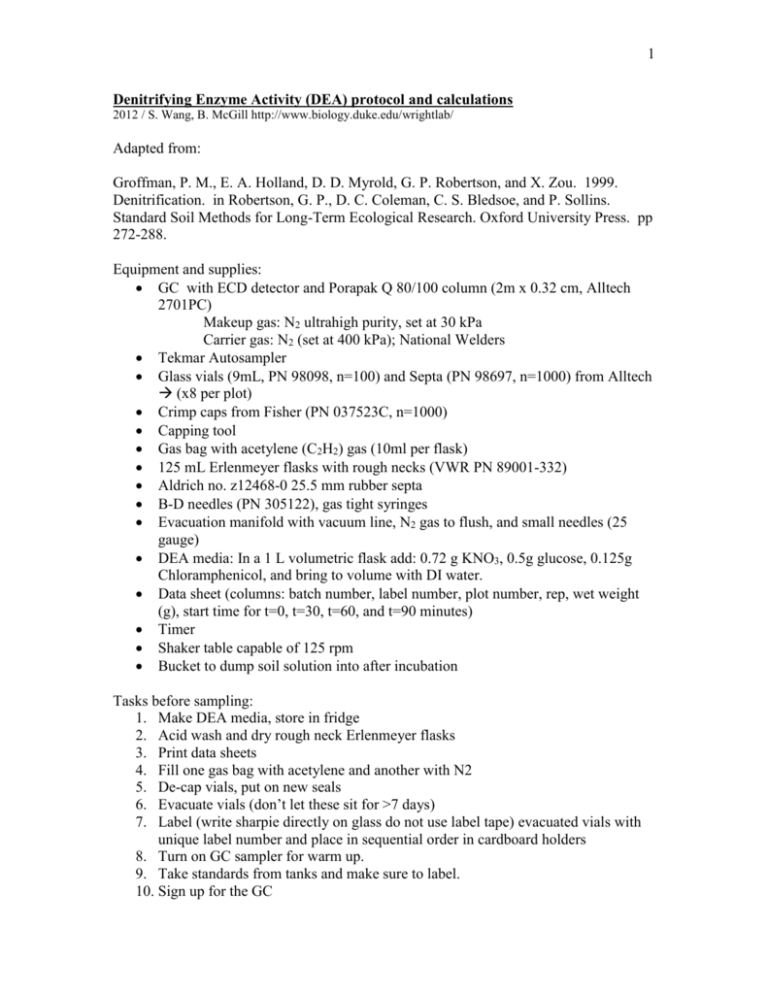Denitrifying Enzyme Activity (DEA) Assay
advertisement

1 Denitrifying Enzyme Activity (DEA) protocol and calculations 2012 / S. Wang, B. McGill http://www.biology.duke.edu/wrightlab/ Adapted from: Groffman, P. M., E. A. Holland, D. D. Myrold, G. P. Robertson, and X. Zou. 1999. Denitrification. in Robertson, G. P., D. C. Coleman, C. S. Bledsoe, and P. Sollins. Standard Soil Methods for Long-Term Ecological Research. Oxford University Press. pp 272-288. Equipment and supplies: GC with ECD detector and Porapak Q 80/100 column (2m x 0.32 cm, Alltech 2701PC) Makeup gas: N2 ultrahigh purity, set at 30 kPa Carrier gas: N2 (set at 400 kPa); National Welders Tekmar Autosampler Glass vials (9mL, PN 98098, n=100) and Septa (PN 98697, n=1000) from Alltech (x8 per plot) Crimp caps from Fisher (PN 037523C, n=1000) Capping tool Gas bag with acetylene (C2H2) gas (10ml per flask) 125 mL Erlenmeyer flasks with rough necks (VWR PN 89001-332) Aldrich no. z12468-0 25.5 mm rubber septa B-D needles (PN 305122), gas tight syringes Evacuation manifold with vacuum line, N2 gas to flush, and small needles (25 gauge) DEA media: In a 1 L volumetric flask add: 0.72 g KNO3, 0.5g glucose, 0.125g Chloramphenicol, and bring to volume with DI water. Data sheet (columns: batch number, label number, plot number, rep, wet weight (g), start time for t=0, t=30, t=60, and t=90 minutes) Timer Shaker table capable of 125 rpm Bucket to dump soil solution into after incubation Tasks before sampling: 1. Make DEA media, store in fridge 2. Acid wash and dry rough neck Erlenmeyer flasks 3. Print data sheets 4. Fill one gas bag with acetylene and another with N2 5. De-cap vials, put on new seals 6. Evacuate vials (don’t let these sit for >7 days) 7. Label (write sharpie directly on glass do not use label tape) evacuated vials with unique label number and place in sequential order in cardboard holders 8. Turn on GC sampler for warm up. 9. Take standards from tanks and make sure to label. 10. Sign up for the GC 2 Steps: 1. 2. 3. 4. 5. 6. Evacuate and flush 9mL vials: if needles stick, may need to put on new needles a. 30 sec vacuum, 5-10 sec N2 flush (2 x evac, 2 x flush) b. End with 2 min vacuum: evacuated vial; turn off valves before turning off vacuum c. Need 4 vials per rep, plus for standard curve Weigh 2 reps of 5 g (± 0.5g) of sieved, homogenized soil into 125 mL Erlenmeyer flasks Loosely cap flasks with red rubber stopper if they will be left overnight in cold room Add 10mL of DEA media to each flask and cap tightly with red stopper cap Anoxia: evacuate and flush a. 3 min evac, 1 min N2 flush – complete sequence 3 times. Use a fine-gauge needle to bring the flask to atmospheric pressure INCUBATION begins with acetylene injection 7. Add 10mL acetylene from gas bag to each flask. Pump up and down 3 times. Take out 10mL gas sample and inject into evacuated vial. This is T=0min sample. 8. Record start and finish times. 9. Place flasks on shaker table at 125 rpm for ~20min 10. At T=30min, take out 10mL gas sample from each flask and inject into evacuated vial. Add 10mL N2. 11. Put flasks back on shaker table for ~20min, until T = 60min 12. At T=60min, take out 10mL gas sample from each flask and inject into evacuated vial. Add 10mL N2 13. Put flasks back on shaker table for ~20min, until T = 90min 14. At T=90min, take out 10mL gas sample from each flask and inject into evacuated vial. This is the end of the incubation. Note: In down time, you can weigh more samples, wash and dry DEA flasks, take standards, evacuate vials, label vials, etc. Explanation of the Denitrification Enzyme Assay Calculations By Ariana Sutton-Grier The output from the gas chromatograph is in ppm by N2O gas volume. In other words, it is given as one volume unit of N2O for every one million volume units of other gases in the sample. The calculations that then convert this number to ppb (parts per billion) of N by soil dry weight are as follows. 1. Divide number by 24 (the gas constant) to get the number of moles per unit volume. ppm(volume) = mL/L = nL/mL 3 (nL/mL)(nM N2O/24 nL)=> nM/mL 2. Multiply the result of step 1 by 44 (molecular weight) to get the nanograms of N2O/mL. (nM/mL)(44 ng N2O/nM)=> ng N2O/mL 3. Multiply the result of step 2 by 0.636 to get the nanograms of N/mL. (ng N2O/mL)(0.636 ng N/ng N2O)=> ng N/mL 4. Multiply the result of step 3 by the headspace (volume of the flask in mL minus the volume of the soil in gr minus the media in mL in the flask) to get the nanograms of N evolved. (ng N/mL)(mL)=> ng N 5. Divide the liquid volume (volume of media + volume of water in the soil) by the headspace. Multiply this by 0.615 (Bunsen) and by the result of step 4 to get the dissolved N gas present in the liquid in the flask. This should be very small. (ng N) weight volume gr and (0.615*(media volume + (wet weight of soil – wet of soil*soil H2O %))) / headspace (which is the of the flask in mL minus the volume of the soil in media in mL in the flask) 6. Add the results of step 4 and step 5 to get the total N (ng) gas produced. Divide this by the dry weight of the soil (wet weight of soil – wet weight of soil*soil H2O %) put in the flask to get the N gas produced per gram of dry soil, parts per billion. ng N/g 7. Subtract the Time 1 result from the Time 2 result to get a rate in parts per billion per hour. ng/g/h




